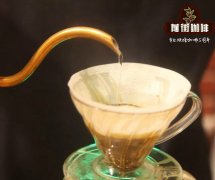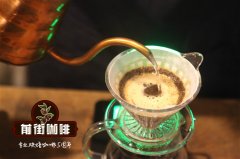What is coffee in Parana, Brazil? Introduction to Cooxup é, the largest coffee cooperative in Brazil

Professional coffee knowledge exchange more coffee bean information please follow the coffee workshop (Wechat official account cafe_style)
Brazil's largest coffee cooperative, Cooxupé, is nearing the end of the coffee harvest (regional cooperation among coffee growers in Guasupe). According to data released on Tuesday, (30) work on the coverage of the cooperation is 91.38% until August 26. The figure represents another increase of 4.14% for the week.
In the same period last year, 87.06% of the Cooxup é area has been harvested. There are fewer crops in the main coffee-producing areas, and rain has been received in some areas these days.
According to the weather chart, heavy rain is expected to fall in Parana and western Sao Paulo this week and is expected to accumulate between 20 and 50 millimeters. However, in Minas Gerais, Brazil's main national food-producing state, and in Espiritu Santo and Bahia, Rain Water should be weak and sparse. In the second half of the week, the temperature is expected to drop very low throughout the production zone.
In the area where Cooxup é is located in the southern state of Minas Gerais, the harvest completion rate is the highest, with 94.04%, followed by S ã o Paulo, with registration of about 93.60%, and finally, Serrado Minero, with a harvest of 87.06%.
Brazil is vividly compared to the "giant" and "monarch" of the coffee world. There are about 3.97 billion coffee trees there, and small farmers now grow 75% of the country's coffee. The number of coffee producers in Brazil is twice or even five times that of Colombia, the third largest coffee producer in the world. Unlike in the past, Brazil's economy is less dependent on coffee, which accounts for only 8% of GDP and 10% of GDP. Before World War II, Brazil accounted for 50% or more of the world's coffee production, now close to 30%, but the country's impact on the world coffee, especially on coffee prices, is significant. For example, two frosts in 1975 and 1994 caused a sharp rise in global coffee prices.
Since the introduction of coffee trees from French Guiana in 1720, coffee production has gradually become a science. Before 1990, the Brazilian government carried out strict monitoring of the coffee industry, with both strict intervention and price protection measures, and the state has been implementing a minimum price protection policy for farmers, resulting in coffee overproduction. Before World War II, the remaining stock reached 78 million bags, which had to be burned by fire or destroyed in the water. Since the opening of the free market since 1990, the original Brazilian Coffee Authority has been replaced by the National Economic Association, the country's non-investment administrative body, which pursues a policy of non-interference and allows producers to negotiate directly with exporters. The business activities of exporters are regulated by government legislation, and the relevant departments register legitimate exporters. Because of the wide variety of Brazilian coffee, we can't just use the word "Brazilian coffee" to include it.
END
Important Notice :
前街咖啡 FrontStreet Coffee has moved to new addredd:
FrontStreet Coffee Address: 315,Donghua East Road,GuangZhou
Tel:020 38364473
- Prev

The origin of Mantenin and its birthplace, what does Mantenin who built Youshan look like?
Professional coffee knowledge exchange more coffee bean information please pay attention to the mystery of the birthplace of coffee workshop (Wechat official account cafe_style) Manning was formerly Java coffee. In order to facilitate the export (Indonesia is a Dutch colony), the Dutch moved Java coffee to the hills on the west side of Sumatra bordering the Indian Ocean, that is, Mann on the border between Jiangsu Province and Jiangsu Province.
- Next

What is the Brazilian Palma Cup? What kind of Brazilian Santos coffee do you have? The characteristics of Santos, Brazil?
Professional coffee knowledge exchange more coffee bean information please follow the coffee workshop (Wechat official account cafe_style) Brazilian coffee is called Brazils to distinguish it from Milds coffee. The vast majority of Brazilian coffee is unwashed and sun-dried and is classified according to the name of the state of origin and the port of transport. Brazil has 21 states and 17 states produce coffee, but four of them produce the most coffee.
Related
- Detailed explanation of Jadeite planting Land in Panamanian Jadeite Manor introduction to the grading system of Jadeite competitive bidding, Red bid, Green bid and Rose Summer
- Story of Coffee planting in Brenka region of Costa Rica Stonehenge Manor anaerobic heavy honey treatment of flavor mouth
- What's on the barrel of Blue Mountain Coffee beans?
- Can American coffee also pull flowers? How to use hot American style to pull out a good-looking pattern?
- Can you make a cold extract with coffee beans? What is the right proportion for cold-extracted coffee formula?
- Indonesian PWN Gold Mandrine Coffee Origin Features Flavor How to Chong? Mandolin coffee is American.
- A brief introduction to the flavor characteristics of Brazilian yellow bourbon coffee beans
- What is the effect of different water quality on the flavor of cold-extracted coffee? What kind of water is best for brewing coffee?
- Why do you think of Rose Summer whenever you mention Panamanian coffee?
- Introduction to the characteristics of authentic blue mountain coffee bean producing areas? What is the CIB Coffee Authority in Jamaica?

